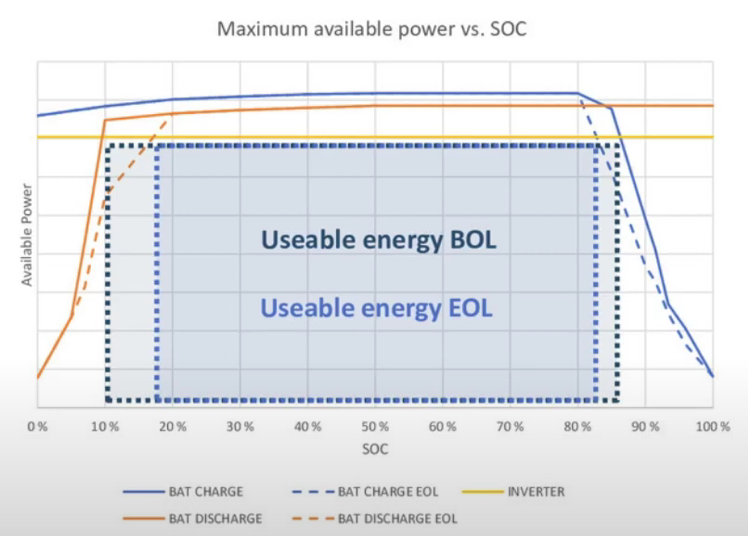Why battery system designs need to be flexible
After visiting battery markets in Germany, America, Belgium and France, we are now looking at two aspects they all face together with our contributors from ECO STOR and AFRY: battery system design and the challenges of revenue forecasting. Batteries are long-term investments with an average lifespan of 5-20 years, which conflicts with the idea of day-to-day optimization where immediate or short-term market conditions govern operational decisions. The energy market is highly volatile, and the regulatory frame is changing fast. Unlike wind and solar, batteries currently have no guaranteed feed-in tariffs, and operators carry the full market risk. However, lowering investment costs to mitigate this risk does not solve the problem.
State of charge versus useable battery power
There is a discrepancy between available power and SoC, which is restricted by factors like (dis)charging limits, inverter power and temperature. This means that the useable energy at the beginning of life differs from cell to cell and from cell chemistry to cell chemistry. Ensuing considerations include:
- trading can only occur during this restricted availability
- upper and lower SoC ranges are inaccessible to constant high power (dis-)charges
- thermal energy loss increases with power
- useable energy decreases as the power output rate increases (for example, the same cell in a 1-hour system equates to 70% usable energy of the nominal capacity at the beginning of life, in a 2-hour system to 80% and in a 4-hour system to 90%)

Source: ECO STOR
*BOL = beginning of life | EOL = end of life
Useable energy should not be confused with round-trip efficiency, which is above 90% for direct current in all cases. Battery performance warranty dictates strict temperature limits as
- thermal losses increase quadratically with power
- manufacturers specify not only a temperature range but also a temperature delta (deviation between operating and ambient temperature)
Therefore, it is crucial to have a powerful HVAC (heating, ventilation, air conditioning) concept. Various technologies are required to control the humidity, temperature and air purity in an enclosed space. Without strong mechanisms for ventilation and climatization to keep battery cells below 5°C, prefabricated container solutions are limited to one cycle per day. With a proper system in place, you can reach 3-4 cycles a day, which is necessary to exploit the full earning potential of a battery.
Battery lifetime as part of cross-market optimization
The challenges of revenue forecasting over the lifetime of a battery
Developers and operators face uncertainties when it comes business models for BESS (battery energy storage systems). Due to variations in modelling methodology, market design, technology costs and regulatory developments, projecting revenues for the full lifetime of a battery, which typically ranges anywhere from 5 to 20 years, can be quite challenging. Each of these 4 problem areas comes with a set of contributing factors.
Modelling methodology
- Trading performance might not match modelled revenue stacks
- High value/low probability scenarios generate the most money but are hard to model
- Modelling techniques are not universally suitable (method used for 1 MW battery can't be applied 1:1 to a battery with hundreds of MW)
Market design
- For maximum profit, different markets need to be optimized (day-ahead, intraday, ancillary services, balancing mechanism)
- Ancillary market rules are constantly changing, which exposes your battery to risks
- Constraints programmed into the battery model need to be up-to-date for realistic performance predictions
Technology costs
- Development of battery system costs and cyclical investment patterns
- Emergence of new storage technologies
- Battery degradation depends on depths of discharge
Regulatory developments
- Cross-border market integration (MARI*, PICASSO*)
- Growth of renewables and reduction of fossil-powered energy gives batteries lots of opportunities, but we need to keep in mind where government support for other forms of flexibility such as hydro, thermal and long-duration storage goes
*Manually Activated Reserves Initiative; Platform for the International Coordination of Automated Frequency Restoration and Stable System Operation
These points illustrate effectively just how many factors go into the science of predicting asset profitability. Batteries with a flexible system design facilitate cycling activities and, by extension, revenue forecasts.
Interested in how batteries behave on international markets?
Check out examples in Germany, the United States, Belgium and France or follow us on LinkedIn to stay on top of the latest developments.
